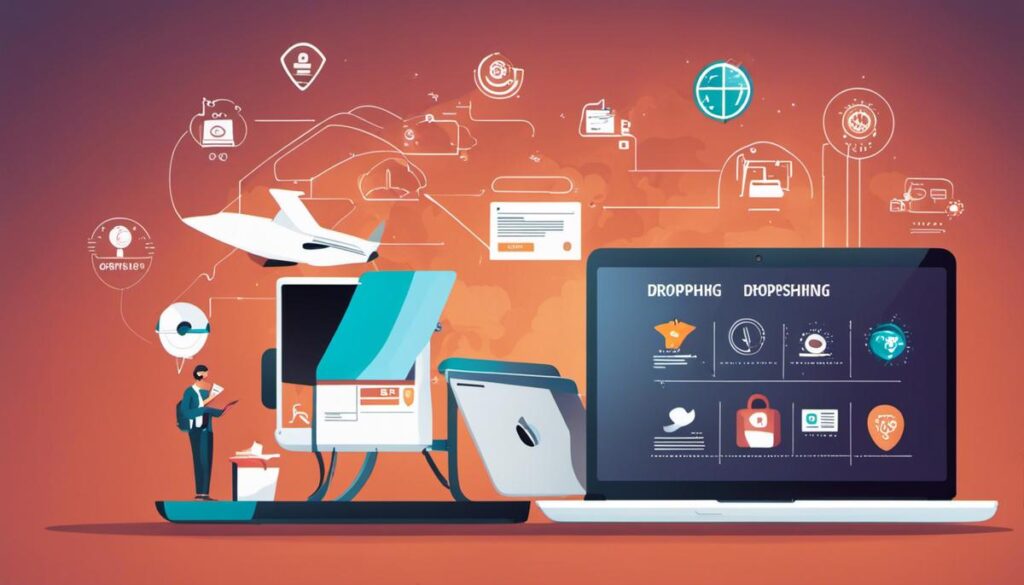Dropshipping has emerged as a popular ecommerce business model that allows entrepreneurs to operate without maintaining inventory or owning a warehouse to store products. Instead, the seller, or ‘dropshipper’, sells the product, and a third-party supplier ships it directly to the customer. In this age of digital revolution, understanding the workings of dropshipping can open up a way for endless business opportunities. By comprehending how to set up, manage, market, and scale your dropshipping business, you can step into the industry with confidence. Well-executed strategies can lead you towards a rewarding business venture that’s capable of expanding far beyond initial expectations.
Understanding Dropshipping
Concept of Dropshipping
Dropshipping is an e-commerce business model where the business owner sells products to customers but doesn’t actually hold any inventory. When a dropshipper sells a product, they purchase the item from a third party—usually a wholesaler or manufacturer— who then ships the product directly to the customer. This way, the seller never actually handles the product.
How Does Dropshipping Work?
In the traditional retail model, the retailer maintains their own inventory. They would bulk order their inventory from a wholesaler, store it either in a physical location or warehouse, and then package and ship the products themselves as they are sold. Dropshipping, however, varies because the seller doesn’t stock or own inventory. Instead, when a dropshipping store sells a product, it purchases the item from a third party and has it shipped directly to the customer. This third party is often a wholesale retailer or another entity that operates as a warehouse.
Key Players in The Dropshipping Model
There are three key players in the dropshipping model: the manufacturer, the retailer (you), and the customer. The manufacturer creates the product, maintains inventory and ships the product to the customer on your behalf. The retailer (you) is responsible for marketing and selling the product but doesn’t hold or own any inventory. Instead, you purchase the product from a manufacturer when you receive an order from a customer. The customer buys the products directly from you, the retailer.
Benefits of Dropshipping
- Low Startup Costs: Unlike traditional retail businesses, starting a dropshipping business doesn’t require a huge investment. The fact that you don’t need to invest in inventory upfront means the financial risk is significantly lower.
- Ease of Operation: Since you don’t have to deal with purchasing inventory or managing a warehouse, your business operations are quite easy to handle. The third-party supplier looks after product storage, packaging, and shipment.
- Location Flexibility: A dropshipping business can be operated from anywhere with an internet connection. As long as you’re able to maintain communication with your suppliers and customers, you can run your business.
- Wide Selection of Products: Since you don’t have to pre-purchase the items you sell, you can offer a wide variety of products to your customers.
Challenges in Dropshipping
- Dependency on Third-Party Suppliers: Since you’re not in control of product fulfillment, you’re relying on third-party suppliers to ship products on time and handle any problems that come up during the process.
- High Competition: As the barrier to entry is low, competition can be high in dropshipping.
- Slim Profit Margins: Profit margins can be slimmer than traditional retail models as you’re acting as a middleman.
Introduction to Dropshipping
Dropshipping offers an attractive, low-risk method to initiate selling products online. Although it has its limitations and challenges, it’s a potential business model you may want to consider if you’re exploring e-commerce opportunities. Its substantial flexibility and minimal start-up costs make it an appealing option for both aspiring and seasoned business entrepreneurs.

Setting Up Your Dropshipping Business
Choosing Your Dropshipping Niche
The initiation of your dropshipping venture must start with selecting a niche or specific market. In the highly competitive world of dropshipping, it’s crucial to identify a distinct niche that promises high product demand and faces limited competition. This requires a thorough investigation of various industries, an understanding of market trends, and a reflection of your personal passions and skills. Ideally, pinpoint a niche that aligns with your interests as this fosters higher chances of success in a field you earnestly enjoy.
Locating Quality Suppliers
Once you’ve identified a niche, the next step is to find trusted suppliers. Your suppliers play a critical role in your dropshipping business because they’re responsible for storing, packing, and shipping your products to your customers. Reliable suppliers reduce the likelihood of logistical issues and customer dissatisfaction. It’s also essential to consider a supplier’s location, shipping times, costs, and the quality of their customer service.
To find suppliers, you can use wholesale directories, attend trade shows and exhibitions, or use internet searches and specialized platforms like Alibaba. Be sure to vet potential suppliers thoroughly. Asking for referrals, reading customer reviews, and testing their services with small orders is wise before committing long-term.
Setting up an E-commerce Website or Platform
After choosing a niche and securing suppliers, the next step is to build a website or online platform to showcase your products. Platforms like Shopify and WooCommerce offer user-friendly templates to create your online store. It’s also possible to use online marketplaces like eBay or Amazon, but having your website gives you more control over your brand and customer interaction.
Your website should be user-friendly and visually appealing. Including high-quality product images, detailed descriptions, and customer reviews can help in driving sales. Integrating secure payment gateways and offering excellent customer service also increase consumer trust in your store.
Complying With Legal Requirements
When building your dropshipping business, comply with relevant legal requirements in your area. You might need to register your business, get a tax identification number, and understand all legal obligations related to e-commerce. Some states may require an online sales tax, while others might have specific regulations regarding product labeling or shipping. It’s advisable to get legal advice to ensure your business operates within the law.
Use of E-commerce Tools and Software
To run a successful dropshipping business, you might need various e-commerce tools and software. Inventory management systems can help monitor stock levels and order volumes from suppliers. Customer relationship management (CRM) tools help you handle customer queries, complaints, and feedback in one place.
SEO tools can optimize your website to increase its visibility online. Email marketing software is useful for reaching out to customers and keeping them engaged. Google Analytics is invaluable in tracking your website’s performance and understanding customer behavior.
Understanding Dropshipping Business
Dropshipping is a retail fulfillment method where a store doesn’t keep the products it sells in stock. Instead, when a store sells a product, it purchases the item from a third party and has it shipped directly to the customer. As a result, the seller doesn’t have to handle the product directly.
Establishing a successful dropshipping business requires careful attention to various aspects. It is integral to choose a suitable niche, locate trustworthy suppliers, create an efficient website, and meet all legal requirements for your business. Every single one of these factors plays a significant part in the feasibility and overall success of the business.

Managing Your Dropshipping Business
Overseeing Order Processing in Dropshipping
In a dropshipping business, a fundamental responsibility is overseeing order processing. This includes accepting customer orders, initiating order processing, and forwarding details to suppliers. As a dropshipper, your business model means you do not manage any inventory yourself. Instead, the supplier deals with inventory management and ships products directly to customers. This necessitates effective communication with suppliers to ensure precise orders and prompt delivery. Employing an efficient system, such as dropshipping software to automate this process, is highly advisable.
Inventory Management in Dropshipping
Inventory management can be a challenge in dropshipping, especially since business owners do not have direct control over their supplier’s inventory. Mismanaged inventory can lead to customer dissatisfaction, as they may be told an item is unavailable only after they complete their purchase. To mitigate this, many dropshippers use inventory management tools that allow them to sync with their suppliers’ data, offering real-time visibility of stock levels.
Managing Shipping in Dropshipping
In a dropshipping business model, suppliers are responsible for shipping products directly to the customers. Therefore, owners must make arrangements with their suppliers to understand various shipping options, related costs, and estimated delivery times. Owners should incorporate this information into their online store to provide a smooth and efficient customer experience. Additionally, tracking systems should be in place for customers to monitor their order’s progress.
Customer Service in Dropshipping
Customer service is integral to successful dropshipping operations. Effective communication with customers can increase satisfaction and build loyalty. This can involve managing inquiries, providing information about products, handling complaints, and dealing with returns or refunds. Excellent customer service also means responding promptly to customer queries, being transparent about shipping times and potential delays, and handling complaints professionally.
Handling Returns in Dropshipping
As with traditional retail, dropshipping businesses must have an effective return policy. Since you’re dealing with suppliers who may have different return policies, it’s essential to understand these policies and communicate them clearly to your customers. In some cases, suppliers might accept returns themselves, while in others, returns may need to be sent to the dropshipper for processing.
Dealing with Challenges in Dropshipping
Managing a dropshipping business comes with several challenges, including lack of control over inventory and shipping, supplier errors, low-profit margins due to high competition, and potential order fulfillment issues. However, these challenges can be mitigated through careful supplier selection, effective inventory and order management, excellent customer service, and strategic pricing. Successful dropshipping also relies on finding a unique selling point, so consider specializing in a niche market or offering high-quality goods to stand out from competitors.
Mastering Scaling Strategies for Your Dropshipping Business
When seeking to elevate your dropshipping business to new heights, there are several imperative strategies to consider. You might want to delve into Search Engine Optimization (SEO) to amplify your organic traffic. Likewise, delving into the realm of social media advertising could offer significant pay-offs. Enhancing your website design for an optimal customer experience is another initial step along this journey. Going further, you might expand your product range, venture into new markets, or even collaborate with additional suppliers to effectively scale your business.

Marketing Your Dropshipping Business
Effective Marketing Practices for a Prosperous Dropshipping Business
Your dropshipping business’s triumph hinges on implementing potent marketing strategies. One key strategy is leveraging Search Engine Optimization (SEO). By enhancing your website’s SEO, you can attract more organic traffic by securing a coveted spot on search engine result pages. Achieve this by deploying keywords that resonate with your product and industry, refining your website’s design, and building quality backlinks to your site.
Not to be overlooked is the power of email marketing. This tactic involves amassing emails from your potential customers and sending them personalized content that showcases your products. An adept email marketing strategy keeps your customers in the know regarding new product launches, enticing discounts, or other relevant updates in your business. By doing so, you maintain customer engagement and increase the likelihood of them making a purchase from your site.
The Power of Social Media Marketing
Social media marketing is also a crucial aspect of promoting a dropshipping business. Platforms such as Instagram, Facebook, Twitter, Pinterest, and others can help a business reach out to its target audience. You can post engaging content, run ads, and even directly message potential customers. It’s important to be proactive on these platforms by regularly posting engaging content and responding to customer inquiries or comments.
Content Marketing and Dropshipping
Content marketing is an inbound marketing tactic that relies on the creation and sharing of relevant, valuable, and consistent content to attract and retain a defined audience. For a dropshipping business owner, this could translate into running a blog that offers information relating to the products sold. For instance, if you are selling cooking tools, you could publish blogs about recipes, cooking techniques, and how-to-use guides for your products. By offering valuable, relevant content, you can attract potential customers to your site.
Customer Relationship Management
Customer Relationship Management (CRM) is a strategy for managing a company’s interactions with potential and existing customers. In a dropshipping business, CRM is vital as it helps in retaining customers by enhancing their shopping experiences. A key aspect of CRM is the follow-up process on customer inquiries and orders. Prompt, personal responses can help build trust and loyalty, leading to repeat business. It can also include providing excellent customer service and thoughtfully addressing concerns or issues customers may have.
Retaining Customers in Dropshipping Business
To have a thriving dropshipping business, it’s not enough to just attract customers – retaining them is equally as important. By ensuring their satisfaction through excellent product quality, fast shipping, and impressive customer service, customers are more likely to keep coming back. Remember, a satisfied customer can become a loyal customer and brand ambassador, promoting your business by word-of-mouth, which is a highly effective marketing tool.
A combination of several strategies — SEO optimization, email marketing, social media marketing, content marketing, and customer relationship management — can significantly enhance your dropshipping business. These strategies work harmoniously to strengthen your marketing efforts, leading to potential improvements in customer retention and increased revenue.

Scaling Your Dropshipping Business
Enhancing Dropshipping Business Through Product Range Expansion
Extending the variety of products you offer is an influential strategy to scale your Dropshipping business. Offering an array of products caters to a broader customer base and allows you to benefit from various trending items and seasonal demands. Keep in mind the importance of sustaining product quality and satisfying consumer’s demands. This process requires a deep insight into your customers’ preferences and market trends.
Extending Market Reach
Another essential approach to scaling your dropshipping business is extending your market reach. This move involves penetrating new geographic territories or targeting new demographic or market segments. Through strategies such as search engine optimization (SEO), social media marketing, and influencer partnerships, you can broaden the visibility of your ecommerce store. Additionally, expanding to international markets could be a lucrative move, but it requires a thorough understanding and respect for cultural, economic, and logistic differences among varying regions.
Prudent Financial Management
Financial management is another vital aspect to consider when scaling your dropshipping business. It’s important to review your financial performance continually and make necessary adjustments. This task includes optimizing your pricing strategy, examining your expenditure, managing supplier relationships to improve terms, and carefully monitoring cash flow. The use of financial management tools and software can assist with this complex task.
Hiring the Right Staff
In many cases, scaling your dropshipping business will mean that it’s impossible for you to manage all aspects single-handedly. Hiring additional staff or outsourcing certain tasks can help manage the increased workload. Whether it’s customer service, marketing, administrative tasks, you’ll need to ensure that you have the right team in place to support growth and maintain quality service. Remember to invest in staff training so that they understand your business model and adhere to your quality standards.
Continual Improvement
Finally, one of the key aspects of scaling any enterprise is a commitment to continual improvement. This includes refining your business model as needed, staying updated on relevant laws and regulations, staying abreast of trends in ecommerce and dropshipping, and continually optimizing your website for user experience. To keep improving, you need to track key performance indicators (KPIs) and use analytics to understand your business data. Regularly review processes, platforms, and partnerships to ensure they are providing the best value and performance.
Incorporating Technology
Leveraging technology is another critical factor in scaling your dropshipping business. Use automations to streamline your processes, manage customer orders more efficiently and provide exceptional customer service. Ecommerce platforms, inventory management tools, customer relationship management (CRM) systems, SEO tools are all valuable assets to help your business grow. They can help you manage increased demand without sacrificing customer experience or impacting your operational efficiency.
Forming Strategic Partnerships
Form strategic alliances or partnerships with suppliers, major clients, or even other ecommerce businesses where synergies can be achieved. By connecting with other businesses, you can leverage their strengths, platforms, or networks to boost your own business growth. This could lead to increased revenue, improved supply chains, and a larger customer base.
In conclusion, scaling your dropshipping business is not an easy task, but with strategic planning and careful execution in areas like product expansion, market reach, financial management, hiring, continual improvement strategies, incorporation of technology, and strategic partnerships, you can successfully grow your undertaking.

Throughout the journey of a dropshipping business, even with its unique set of challenges, it offers an exploratory pathway to entrepreneurship with comparatively less risk. With a comprehensive understanding of setting up your business, managing operations, marketing, and expansion techniques, you can pave a way towards a successful ecommerce venture. Remember, success doesn’t necessarily come overnight, but with persistence, creativity, and effective strategies, it’s possible to build a profitable dropshipping business. As technology continues to evolve and the ecommerce market grows, seize the opportunity to embark on this rewarding venture into dropshipping.







